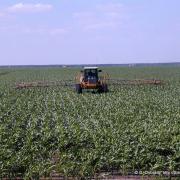Table of Contents

- Introduction
- Current Potential for Use as a Biofuel Feedstock
- Biology/Adaption
- Production
- Production Challenges
- References
- Contributors
Introduction
Castor bean (Ricinus communis L.) has been used for many years as an industrial oilseed crop because of its high seed oil content ( ~50%), unique fatty acid composition (high in ricinoleic acid)and lubricity, potentially high oil yields (from <100 to >250 gallons/acre have been reported), and its ability to grow under varying …







